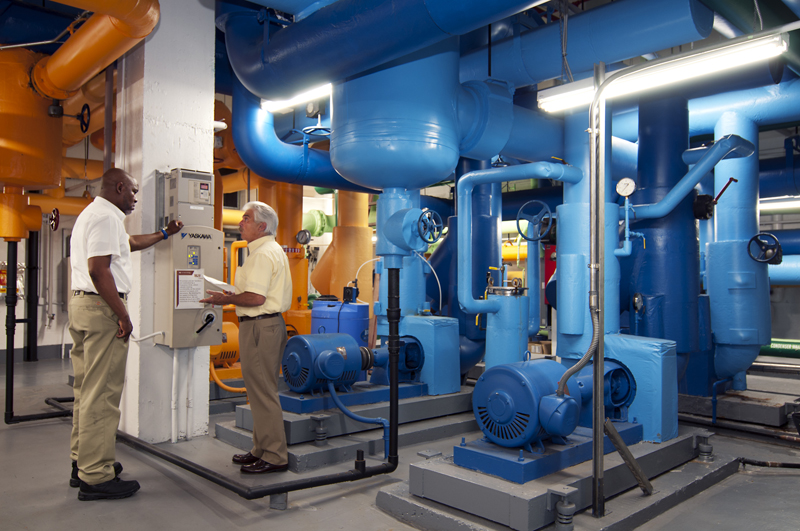This case study features a Tower Companies property.

2020 has proven that changes are always coming to the real estate sector, so how can building owners future-proof their investments? With tenants now more focused than ever on health and with many firms increasing their Environmental, Social and Governance (ESG) commitments, new strategies are needed to attract and retain tenants while keeping costs low. Smart building technology is often discussed as the next advance in building management systems (BMS) because it helps otherwise disparate building systems communicate in a way that optimizes whole building performance by automating the operation. The technology can provide real-time data on occupancy, air quality, BMS points, energy use, and can even correlate tenant work orders to real-time building performance. However, despite all of the benefits, these systems can be costly and complicated to install, and a simple payback doesn’t always explain the full suite of benefits that could arise from implementation—which can stifle adoption in an inherently risk-averse industry.

Credit: John Cole Photography
Eric Harris, building engineer at 1707 L St NW, with Jim Lewis, Vice President of engineering. Photo courtesy of The Tower Companies.
The Tower Companies, a family-owned D.C. real estate firm that prioritizes environmentally responsible buildings, has long discussed the possibility of smart building technology, but often hesitated because of the many uncertainties involved. Jonathan Bauer, Tower’s former Sustainability Manager, says there were a laundry list of barriers, from the unproven software to the highly technical implementation, the lack of case studies, overwhelming number of smart building software companies, cost, and overall complexity. Then, in 2019, the U.S. Department of Energy (DOE) and Lawrence Berkeley National Laboratory (LBNL) announced a U.S. Department of Energy (U.S. DOE) Better Buildings field validation study opportunity to test a smart building technology product from Prescriptive Data, based in New York. The software, Nantum OS, like an operating control system, is designed to optimize building performance using machine learning to automate building operations. Nantum OS analyzes real-time data, such as zone-by-zone occupancy, energy data, BMS points, and Internet of Things (IoT) sensors monitoring metrics like temperate and relative humidity, which can help identify energy conservation measures and lead to notable energy savings.
Bauer knew he needed to evaluate the proposal carefully and that, even if he found it convincing, it would be take some additional effort to convince key decision-makers within his company to go forward. The advantages of participating would include data review and validation from experts at U.S. DOE and LBNL, meaning Tower would get an unbiased perspective on the technology’s effectiveness. Additionally, the opportunity would put a Tower building at the cutting edge of the smart technology trend while also advancing the company’s sustainability goals. However, there were few other examples to learn from, especially in the DC area, and Tower would be responsible for all costs associated with the system.
As part of the due diligence process, Bauer and Tower’s Vice President of Engineering, Jim Lewis, visited buildings in New York City that use Prescriptive Data’s system in early 2020 (pre-COVID19). They learned that the original product was created by another large family-owned company, Rudin Management Company (Rudin), for use across their own portfolio. When Rudin realized there was commercial interest, they spun the product off independently. This was reassuring to Bauer and Lewis, as it showed the technology was built for a company with similar needs and, most importantly, it had worked. The Tower team also reviewed several Nantum case studies outside of Rudin’s operations, which was critical in the decision making process. The review revealed that Tower’s implementation would be slightly different than what had been done in New York City.
Onsite conversations and inspections validated the expected energy savings, and they also revealed something else: smart building technology is the future of buildings. With the broader trends toward data-driven decision-making, automation, healthy indoor air, and sustainability, having this technology could be essential for a company like Tower. Related to this, IoT is pervading products, making everything from refrigerators to security systems connected to the internet for real-time decision-making and information sharing. Building managers must keep pace with all of these changes by creating “smarter buildings” that can compete to provide the key services demanded by tenants. “The energy and cost savings benefits were important, but what tipped us over the edge was that this is the technology of the future. If we don’t get in as an early adopter, we’ll fall behind, especially in a competitive market like DC,” Bauer explained.
“The energy and cost savings benefits were important, but what tipped us over the edge was that this is the technology of the future. If we don't get in as an early adopter, we'll fall behind...Jonathan Bauer, former Sustainability Manager, The Tower Companies
The system is now online at 1828 L Street NW, and, while there are still some unknowns about how the system will perform, the team feels confident about the decision. The emergence of the COVID-19 pandemic in March 2020 validated the need for the project. For example, Tower’s tenants are clamoring for information on how healthy the spaces in the building are—companies are even sending in their own mechanical engineers before returning to the office—so it’s clear that buildings with quantifiable health measures are already in demand. Tower has incorporated some additional sensors that will track things such as relative humidity, carbon dioxide, carbon monoxide, and temperature, which, combined with the automatic HVAC controls and occupant tracking, make the building an attractive office space. The engineering team will also be able to be more efficient. Bauer explains that “The system is like having another engineer in the building who is reading 25,000 data points and making adjustments automatically while triggering preventive warnings. It doesn’t replace people, but it makes us better at our jobs by helping us work more efficiently—and that is a value add that is hard to quantify in a simple payback calculation.”
“The system is like having another engineer in the building who is reading 25,000 data points and making adjustments automatically while triggering preventive warnings. It doesn't replace people, but it makes us better at our jobs...Jonathan Bauer, Sustainability Manager, The Tower Companies
Building Stats
Address: 1828 L St NW
Square footage: 289,000
No. of floors: 12
Use type: Commercial office
Date constructed: 1965
ENERGY STAR score (2019): 81
Project Team
Owner & Manager: The Tower Companies
- Jonathan Bauer, Sustainability Manager
- Jim Lewis, VP Engineering
- Marvin Atwell, Chief Building Engineer
- Donna Nurmi, Senior Property Manager
Product: Prescriptive Data, Nantum Operating System
Installer: Net 6 Electric, Tower, Prescriptive Data
Third-party Monitoring/Validation: Lawrence Berkeley National Laboratory
Pilot Sponsor: DOE, Better Buildings
Anticipated energy savings: 7-10%
Year 1 Costs: $71,225
Anticipated Payback: Two years

